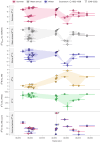Stable isotopes show Homo sapiens dispersed into cold steppes ~45,000 years ago at Ilsenhöhle in Ranis, Germany
- PMID: 38297139
- PMCID: PMC10927559
- DOI: 10.1038/s41559-023-02318-z
Stable isotopes show Homo sapiens dispersed into cold steppes ~45,000 years ago at Ilsenhöhle in Ranis, Germany
Abstract
The spread of Homo sapiens into new habitats across Eurasia ~45,000 years ago and the concurrent disappearance of Neanderthals represents a critical evolutionary turnover in our species' history. 'Transitional' technocomplexes, such as the Lincombian-Ranisian-Jerzmanowician (LRJ), characterize the European record during this period but their makers and evolutionary significance have long remained unclear. New evidence from Ilsenhöhle in Ranis, Germany, now provides a secure connection of the LRJ to H. sapiens remains dated to ~45,000 years ago, making it one of the earliest forays of our species to central Europe. Using many stable isotope records of climate produced from 16 serially sampled equid teeth spanning ~12,500 years of LRJ and Upper Palaeolithic human occupation at Ranis, we review the ability of early humans to adapt to different climate and habitat conditions. Results show that cold climates prevailed across LRJ occupations, with a temperature decrease culminating in a pronounced cold excursion at ~45,000-43,000 cal BP. Directly dated H. sapiens remains confirm that humans used the site even during this very cold phase. Together with recent evidence from the Initial Upper Palaeolithic, this demonstrates that humans operated in severe cold conditions during many distinct early dispersals into Europe and suggests pronounced adaptability.
© 2024. The Author(s).
Conflict of interest statement
The authors declare no competing interests.
Figures






References
-
- Hublin J-J, et al. Initial Upper Palaeolithic Homo sapiens from Bacho Kiro Cave, Bulgaria. Nature. 2020;581:299–302. - PubMed
-
- Jöris O, Neruda P, Wiśniewski A, Weiss M. The Late and Final Middle Palaeolithic of Central Europe and its contributions to the formation of the regional Upper Palaeolithic: a review and a synthesis. J. Paleolit. Archaeol. 2022;5:5–17.
Publication types
MeSH terms
Grants and funding
LinkOut - more resources
Full Text Sources

